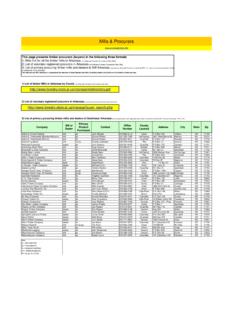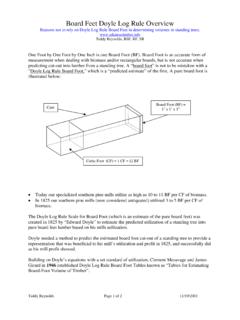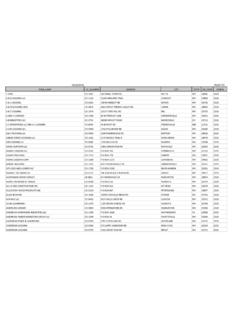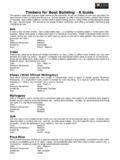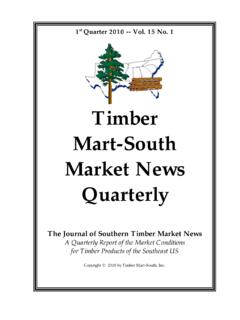Transcription of Lump Sum Pay-As-Cut - Arkansas Timber.info
1 Page 1 of 5 Selling timber Methods Teddy Reynolds, BSF, RF, SR timber sales are traditionally performed in the following two manners: 1) Lump Sum. 2) Pay-As-Cut . A comparison summary of the two above methods is as follows: Item Lump Sum Pay-As-Cut Payment: Prior to logging (at time of sale) After logging starts Logging Term: One to two years One month to two years Negotiation Type: Sealed Bid (occasional direct) Direct (occasional sealed bid) Inventory Required: Prior to Sale (marking or cruise) No Thinning: Trees marked Operator select (sometimes marked) Final Harvest: Trees marked or cruised. Operator select Conveyance: Deed or 631b Contract 631b Contract Lump Sum: Yes, payment before purchase No, payment occurs after harvest Advance Payment: Yes No (occasional advance with settlement) Negotiate Per Ton Rate: No (blended lump sum bid) Yes, for each species and product Provide Volume Report: Yes No Provide Maps (aerial, etc.
2 : Yes Optional Bid Letter: Yes (includes details of sale) Optional Boundaries Identified: Yes Yes BMP Adherence: Written in contract Verbal or written in contract Formal Bid Opening: Yes No Pulpwood Sale: No (occasional) Yes Small Sawlog Sale: Yes Yes Large Sawlog Sale: Yes Yes Less than 20 acres: Seldom Yes Over 20 acres: Yes Yes Capital Gains Treatment: Yes (when conveyed properly) Yes timber Liability: Retained with 631b contract Retained always by landowner Installment Payment Option: Yes Yes Liability Insurance Required: Yes Yes Tree Growth during Contract: Buyer s Gain Seller s Gain Interest Gained from Sale: Seller Gain Buyer s Gain Drop in Market Values.
3 Buyer s Loss Depends on negotiation Increase in Market Values: Seller s Loss Depends on negotiation Consulting Forester Required: No No Trust in Forester: High requirement High requirement Trust in Buyer: Low requirement (if advertised well) High requirement Utilization Trust: No requirement High requirement Mill Reporting Trust: No requirement High requirement Payment Trust: No requirement (occurs first) High requirement Payment Default Recourse: Re-bid or sale to second bidder File Suit (trees already harvested) Abuse Potential: Lower Higher Theft Potential: No, if use tracer in paint Potential always exists.
4 Bid Result Falsification: Yes, if forester uses low volumes Yes, if buyer reports incorrectly Page 2 of 5 Contract Abidance: Higher Lower Mistakes Influencing Value: High High Suits: Lower Higher Cut-Out Accuracy: Varied (based on volume accuracy) Not able to verify Risk: Lower Higher Consulting Preference: Higher Lower Buyer Preference: Lower Higher Landowner Preference: Mixed Mixed Practiced Method: Yes Yes Example of each sale method will be explained and followed by an example.
5 1) Lump Sum 1) timber to be sold is marked with blue paint and classified (tallied) by species, diameter (at feet from ground; dbh), height, form class and grade. A cruise (sample based inventory) can also be used, but the 100% tree marking provides the highest accuracy (or a blend of the two can be used for added accuracy). If a cruise alone is utilized, the probability (usually 90%) and corresponding percent error should be provided to the landowner. Percent error is not to be mistaken with the percent cruise (which refers to the percent surface acres sampled). 2) The marked trees are reported to the prospective bidders by species providing the following information (pine sawtimber, pine pulpwood, oak sawtimber, miscellaneous sawtimber, and hardwood pulpwood; when no grade oak exists then can option to blend all hardwood together): a.
6 Tree count b. Tonnage c. Cubic feet d. Doyle log rule board feet. e. Volume, tons, and logs per tree. f. Volume, tons and trees per Acre. g. Average height and dbh. 3) Utilization for each species and product to the top end diameter is reported to bidders. 4) Volume and tonnage calculations and conversions are provided to bidders. 5) Tree count and dbh should be guaranteed for all 100% marked products by seller or their agent. 6) Bid letter announcement including the following sale details: a. Bid Opening Date and Location (within three weeks of mailing bid prospectus). b. Harvest Type Overview (including Streamside Management Zones (smz) notation and border identities). c. Inventory Method (including paint color and/or cruise specifications).
7 D. Tonnage and timber Summary (tree count, tons, dbh, and height). e. Legal Description and Boundary Line notations (flagging and/or paint color). f. Contract Length (one year for winter and two years for summer logging). g. Logging Conditions (Summer to winter logging and access conditions). h. Method for Bid Receipts (mail, fax, phone, mail, email or at opening). i. Payment & Closing. j. Reservations. k. BMP Guidelines. 7) Aerial Map (with topographic lines, boundary lines, road, smz, etc. overlaid). 8) Vicinity Map (including location of nearest town with highways and county roads named). 9) Directional signs should be posted to the sale and at each of the sale s entrances. Page 3 of 5 The above documents (bid letter, volume report, aerial map, and vicinity map) should be transmitted within an approximate 100-mile radius to all mills and intermediate procurers using the following mediums (no less than 100 recipients): a.
8 Email packages (including jpg maps). b. Mail packages (approximately 10% of procurers do not have emails). c. Web Site. d. Newspaper (optional for those who do not have developed data-base). Prior to the bid opening a Pre- timber Sale Appraisal should be performed for the landowner based on current timber prices by product, which will serve as the critical basis for acceptance or rejection. After bid acceptance and notification, the successful bidder has 30-day to close at which time a timber deed or contract is provided to the purchaser. All timber harvesting specifications and insurance requirements are executed by a deed or contract and legally binding on the purchaser and seller.
9 Bid Ethics: 1) Bid results should be provided to all bidders the day of bid opening. 2) The successful bidder should be accepted the day of or within three days of bid opening. 3) Bids received after set closing time deadline cannot be accepted or entertained. Late bids cannot serve as the basis for renegotiation (bumping prices) or rejection. If such ever occurs, the seller and consultant s future sales will never reach their maximum based on bidder caution. 4) Submitted bids must be kept confidential until bid opening. 5) Steps to follow for rejected bid sales: a. All bids should fall below 5% or 10% of the Pre-Sale timber Appraisal (which is based on current comparable timber sale rates).
10 If sales habitually fall 10% above or below the Pre-Sale timber Appraisal, you should consider contracting a new appraiser. Occasionally, bids are more representative of the current timber market than the pre-sale timber appraisal, and rejection is ungrounded. b. After rejection, the following steps should be followed: Minimum acceptable bid amount must be offered first to the highest bidder. If they pass, then offered to the second bidder, etc. If all bidders pass the minimum offer, then the seller is free to offer the bids outside the initial bid participants. If a non-bidder is offered the purchase before following the above steps, futures timber sales will be affected due to seller distrust.

